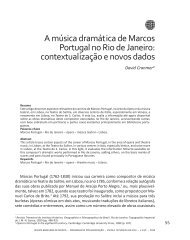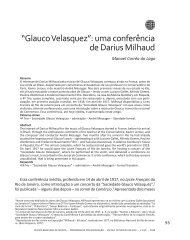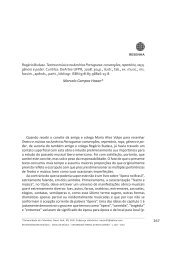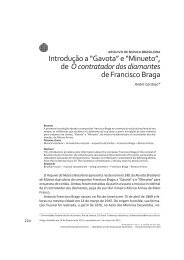- Page 2 and 3: SÉRIE SIMPÓSIO INTERNACIONAL DE M
- Page 4 and 5: UNIVERSIDADE FEDERAL DO RIO DE JANE
- Page 6 and 7: ÓPERA EM TRANSIÇÃO A República
- Page 8 and 9: 8 PREFÁCIO Os estudos de ópera t
- Page 10 and 11: TRÂNSITOS CULTURAIS
- Page 12 and 13: 12 teatros que abrem diariamente as
- Page 14 and 15: 14 pectador por espetáculo; 20 dia
- Page 16 and 17: 16 (desde o século XVIII). Essa é
- Page 18 and 19: 18 como também para promover proje
- Page 20 and 21: 20 and abroad. 4 While I would be h
- Page 22 and 23: 22 century, and still found in coll
- Page 24 and 25: 24 That is why collections outside
- Page 26 and 27: 26 name is found, Bernardo Girard,
- Page 30 and 31: 31 Fantasias operísticas italianas
- Page 32 and 33: 33 Fiquemos com o último desses re
- Page 34 and 35: 35 ausência de qualquer concepçã
- Page 36 and 37: 37 como expressões públicas do de
- Page 38 and 39: 39 tornado recentemente nacional, e
- Page 40 and 41: Viaggi dell’opera verso il Rio de
- Page 42 and 43: 43 Per concludere, anche le distanz
- Page 44 and 45: 45 venivano da porti italiani (143
- Page 46 and 47: 47 Judeu, nella ricerca su Facco, s
- Page 48 and 49: 49 o in Brasile? Esistono documenti
- Page 50 and 51: 51 storia del Trecento, cavata dall
- Page 52 and 53: Moros dannaa, tradii de la morosa,
- Page 54 and 55: 55 Teatro Concordi della città di
- Page 56 and 57: 57 “distinto maestro Bernardi”.
- Page 58 and 59: 59 Il gaucho di Podestà, ebbe, sem
- Page 60 and 61: 61 Comunque credo molto possibile c
- Page 62 and 63: 63 dei genitori di Donna Maria. Tra
- Page 64 and 65: 66 presenta a aristocracia açucare
- Page 66 and 67: 68 Figura 2. Texto da ária de Lour
- Page 68 and 69: 70 Exemplo 1. Instrumentos de sopro
- Page 70 and 71: 72 Exemplo 4. Estilo vocal caracter
- Page 72 and 73: 74 Exemplo 6. Imitação do toque d
- Page 74 and 75: 76 Exemplo 8. Ária de Lídia (cont
- Page 76 and 77: 78 Exemplo 14. Motivo do Barão Teo
- Page 78 and 79:
80 Exemplo 16. Ária de Tomás de O
- Page 80 and 81:
82 Exemplo 17. Cadência do desafio
- Page 82 and 83:
84 representada é “o abismo de i
- Page 84 and 85:
86 de fui aluno, no final da décad
- Page 86 and 87:
88 para abrigar as referências cul
- Page 88 and 89:
90 atravessam de barco o rio São F
- Page 90 and 91:
92 A exemplo da colagem intercambia
- Page 92 and 93:
95 Uma visão atual da ópera no Br
- Page 94 and 95:
97 Heller, O Anjo Negro mostrou ple
- Page 96 and 97:
99 virá […] Puccini jamais deixa
- Page 98 and 99:
101 enterrado na Terra Santa...”
- Page 100 and 101:
103 ciosa dicção que ela encontro
- Page 102 and 103:
105 Velho (como Próspero), Rosana
- Page 104 and 105:
107 Finalmente, Jorge Coli, mais um
- Page 106 and 107:
109 Pereira, William. A Tempestade
- Page 108 and 109:
111 Literatura e música: o romance
- Page 110 and 111:
113 sobre compra de bilhetes, Antô
- Page 112 and 113:
115 final do século XV, invenção
- Page 114 and 115:
117 cariana de arte se aproxima dos
- Page 116 and 117:
119 Carlota. O encontro dentro do v
- Page 118 and 119:
ÓPERA NA AMÉRICA PORTUGUESA
- Page 120 and 121:
124 ou de sátira social como drama
- Page 122 and 123:
126 dessa forma aumentar a prevalê
- Page 124 and 125:
128 vezes que a ópera era repetida
- Page 126 and 127:
130 A primeira ação do Morgado de
- Page 128 and 129:
132 a fazer trinta óperas dentro d
- Page 130 and 131:
134 beneplácito régio, mas nos fu
- Page 132 and 133:
136 estilísticas dos textos, tende
- Page 134 and 135:
138 sentados por bonecos. 6 Ademais
- Page 136 and 137:
140 Duprat, Régis. Música na Sé
- Page 138 and 139:
142 ferente em alguns pontos, como
- Page 140 and 141:
144 utilizados pelo autor e como el
- Page 142 and 143:
146 O plano da ária fica estabelec
- Page 144 and 145:
148 ampliando a noção sensorial e
- Page 146 and 147:
150 [sic], violleta, basso, oboés
- Page 148 and 149:
152 Figura 7. Compassos 14-19 da á
- Page 150 and 151:
154 colonial, ainda que as datas ma
- Page 152 and 153:
156 Janeiro. Para além dos título
- Page 154 and 155:
158 nes, e Maria Candida: entre os
- Page 156 and 157:
160 identificar um conjunto de copi
- Page 158 and 159:
162 Portuguezas e das edições avu
- Page 160 and 161:
165 A República e as mudanças na
- Page 162 and 163:
167 cesa. Em Londres, tornara-se fa
- Page 164 and 165:
169 ou mesmo da ópera francesa (al
- Page 166 and 167:
171 As histórias da música tendem
- Page 168 and 169:
173 volta de 1770, cerca de cem ano
- Page 170 and 171:
175 se e desterrando insensivelment
- Page 172 and 173:
177 É uma fábrica de reputação
- Page 174 and 175:
179 a consistência dos argumentos
- Page 176 and 177:
181 Os ideais republicanos e as mud
- Page 178 and 179:
183 É nesta identificação do Tea
- Page 180 and 181:
185 A “batalha dos símbolos”:
- Page 182 and 183:
187 imaginário músico-teatral, de
- Page 184 and 185:
189 O problema do caráter nacional
- Page 186 and 187:
191 O mesmo crítico faz ainda um b
- Page 188 and 189:
Figura 3. O Paiz, Rio de Janeiro, 2
- Page 190 and 191:
195 Carlos Gomes no contexto da tra
- Page 192 and 193:
197 Verifica-se que Gomes estava em
- Page 194 and 195:
199 Rusticana seria o final deste p
- Page 196 and 197:
Figura 1. Introdução orquestral d
- Page 198 and 199:
203 wagneriana após a estréia do
- Page 200 and 201:
205 Em verdade, Antônio Carlos Gom
- Page 202 and 203:
207 Ainda dentro de uma nova aborda
- Page 204 and 205:
Figura 11. Sequência estrutural do
- Page 206 and 207:
Figura 12. Secção inicial rítmic
- Page 208 and 209:
213 em sua nova estrutura de Finale
- Page 210 and 211:
Figura 23. Peroração final sem re
- Page 212 and 213:
217 Nessa mesma linha, exemplifica-
- Page 214 and 215:
219 correspondendo ao momento em qu
- Page 216 and 217:
221 Mallach, A. The Autumn of Itali
- Page 218 and 219:
224 envolvendo-se no projeto, tamb
- Page 220 and 221:
226 vações nacionalistas, nas dua
- Page 222 and 223:
228 sensual. Outros aspectos import
- Page 224 and 225:
230 no Rio de Janeiro, ter sido ela
- Page 226 and 227:
ESTILO E RECEPÇÃO
- Page 228 and 229:
234 assinou alguns dos painéis e p
- Page 230 and 231:
236 artísticas anuais ao público
- Page 232 and 233:
238 Ao menos um aluno de Gurjão pr
- Page 234 and 235:
240 A comparação dos libretos pub
- Page 236 and 237:
242 Todo o dilema da ópera se resu
- Page 238 and 239:
244 de recursos provocou também a
- Page 240 and 241:
246 do Governador Fileto Pires, o e
- Page 242 and 243:
248 quando doze horas após o baile
- Page 244 and 245:
250 Malcher, José Cândido da Gama
- Page 246 and 247:
252 No que se refere à composiçã
- Page 248 and 249:
254 A ação se passa na Síria, ce
- Page 250 and 251:
256 assustado ao continuar a leitur
- Page 252 and 253:
258 Figura 3. Introdução ao prime
- Page 254 and 255:
260 Figura 7. Coro Rataplan - Sant
- Page 256 and 257:
262 Interessa ainda discutir duas s
- Page 258 and 259:
264 Figura 12. Cena quinta, clímax
- Page 260 and 261:
266 Figura 13. Cena quinta, clímax
- Page 262 and 263:
269 Joanna de Flandres de Carlos Go
- Page 264 and 265:
271 apurando sua técnica de compos
- Page 266 and 267:
Figura 4. Página inicial da partit
- Page 268 and 269:
Figura 6. Trecho inicial - A Conjur
- Page 270 and 271:
Figura 10. Início do dueto de amor
- Page 272 and 273:
Figura 13. Margarida introduz o tem
- Page 274 and 275:
Figura 17. Ato IV, Dueto Joanna e R
- Page 276 and 277:
283 Fontes documentais Museu Histó
- Page 278 and 279:
286 sumida e vulgarizada da Tetralo
- Page 280 and 281:
288 sua estratégia foi fomentar ac
- Page 282 and 283:
290 por Wagner para a formação do
- Page 284 and 285:
292 A edição da abertura de Pelo
- Page 286 and 287:
294 Valoz Júnior, Felipe Ferreira.
- Page 288 and 289:
296 Longe de querer fazer aqui qual
- Page 290 and 291:
298 tório. Musicalmente, percebe-s
- Page 292 and 293:
300 No presente momento, os excesso
- Page 294 and 295:
TRAJETÓRIAS
- Page 296 and 297:
304 Paralelamente a esse extenso tr
- Page 298 and 299:
306 genero, o typo caracteristico d
- Page 300 and 301:
308 dorismo. As diferenças ideoló
- Page 302 and 303:
310 Esse processo de construção d
- Page 304 and 305:
312 Ópera” (apud Araújo, 1985).
- Page 306 and 307:
314 A presença de diferentes recur
- Page 308 and 309:
317 O teatro lírico no Brasil meri
- Page 310 and 311:
319 o sentimento nativista amadurec
- Page 312 and 313:
321 Todavia, musicalmente, Il Guara
- Page 314 and 315:
323 Das peças líricas mais repres
- Page 316 and 317:
325 cificamente, e norte-europeia d
- Page 318 and 319:
327 29 de setembro, estreando no Te
- Page 320 and 321:
329 Fosca, todas peças já conheci
- Page 322 and 323:
331 lieder, volkslieder, cantatas,
- Page 324 and 325:
333 Outro nome de destaque no canto
- Page 326 and 327:
335 O compositor Carlos Gomes (1836
- Page 328 and 329:
337 Azevedo, Luiz Heitor. Relação
- Page 330 and 331:
339 A ópera Jupyra no contexto ger
- Page 332 and 333:
341 A 30 de julho de 1897, em nova
- Page 334 and 335:
343 da impressão pessoal. Nossas d
- Page 336 and 337:
345 bre a minha pretensão, e elle
- Page 338 and 339:
347 Europa. Triste fato este, que p
- Page 340 and 341:
349 sua produção europeia nos úl
- Page 342 and 343:
351 de maior glória na carreira do
- Page 344 and 345:
353 2) A fonte B não foi utilizada
- Page 346 and 347:
356 22 de janeiro, aproximadamente,
- Page 348 and 349:
358 Exemplo 1a. Introdução da ár
- Page 350 and 351:
360 Tabela 3. Início da cavatina N
- Page 352 and 353:
362 A constatação do uso desses r
- Page 354 and 355:
364 Exemplo 19c. e”1839d”1843.
- Page 356 and 357:
366 Exemplo 24a. Cavatina de Aladin
- Page 358 and 359:
368 Exemplo 25. Posições da clari
- Page 360 and 361:
370 Exemplo 29. Início das clarine
- Page 362 and 363:
372 Referências bibliográficas An
- Page 364 and 365:
375 Emílio Soares e a ópera: ress
- Page 366 and 367:
Figura 1. Compassos iniciais do Lib
- Page 368 and 369:
379 gura de Emílio Soares, como co
- Page 370 and 371:
381 pouco tempo depois, por volta d
- Page 372 and 373:
Figura 10. Jaculatória da Novena e
- Page 374 and 375:
385 Mariana e depois no “Seminár
- Page 376 and 377:
387 Referências bibliográficas An
- Page 378 and 379:
390 música ainda não havia sido c
- Page 380 and 381:
392 Figura 3. Uso do mesmo fragment
- Page 382 and 383:
394 Alexandre Schubert XIV - Ária:
- Page 384 and 385:
396 Figura 6. Modalismo associado a
- Page 386:
398 Desde o princípio, o projeto f






